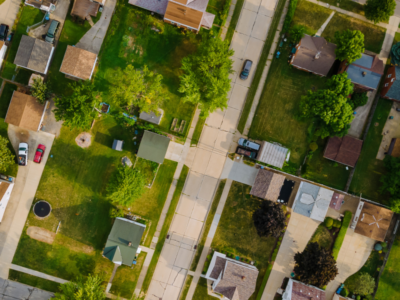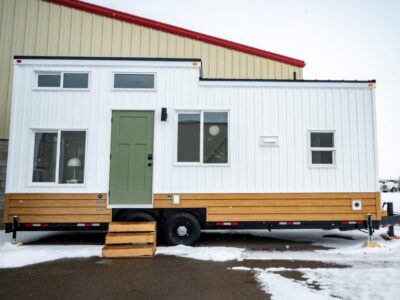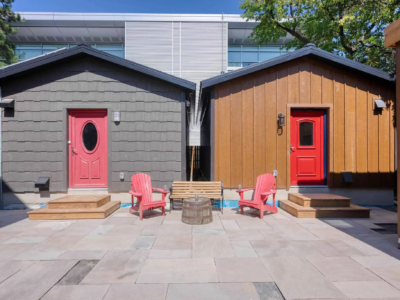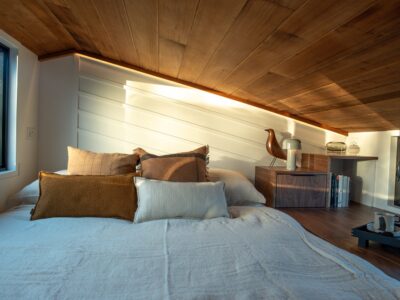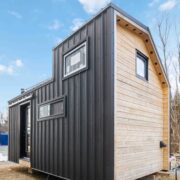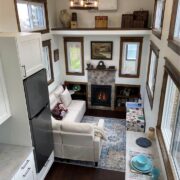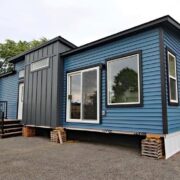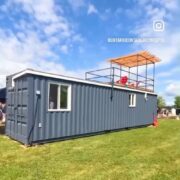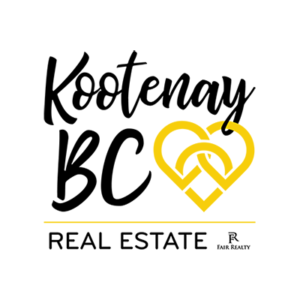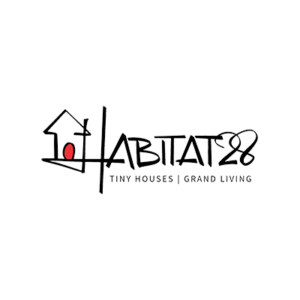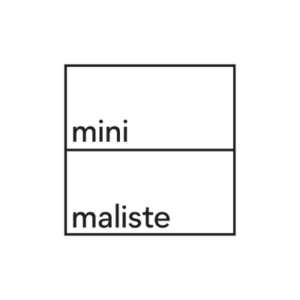Kenton Zerbin: “Tiny houses are a win-win. There are not enough housing options that let you live sustainably.”

If you’re building a tiny house or want to learn more about how homes work and how to make them more natural, Kenton Zerbin’s workshop is a great place to start.
Kenton Zerbin is a tiny house educator who, having come to tiny living through the world of permaculture, incorporates the values of edible landscaping, food forests, and connecting with nature into his programs.
We asked him about tiny living, sustainable construction, and more.

Photo: Kenton Zerbin
Kenton, I know you are teaching all across Ontario this month. Thank you for taking the time out of your busy workshop schedule to speak with me! Here at Tiny Homes in Canada, we are big fans of your work, particularly the nature and permaculture angle to tiny houses. You call it down-to-earth living. Can you tell me how this all came about?
“Originally, I’m a teacher of permaculture, which is a design science for designing humans into their physical and social worlds. When I started teaching that content, I knew that I really wanted to, of course, model the talk. To walk the talk. I have worked on earthships, yurts, strawbale houses, and other alternative homes. There are not enough housing options out there for us to be more in accordance with our values and also in alignment with nature.”
And, so you are living in a tiny house yourself?
“When I finally did come back from my travels, I got really excited about a tiny house. I could get really high quality building materials. I could afford to pay for it mostly outright and not have to buy the land it was on necessarily, and also have smaller heating bills. I got into the tiny house movement because it was the right fit at that point in my life for living a more sustainable lifestyle.”
We often see a close connection between tiny houses and permaculture. It seems many people who live in tiny homes are also interested in permaculture and vice versa. Why do you think that is?
“I would say that permaculturists, when they get into permaculture, are not impressed with what their housing options are. They start questioning and looking for other ways. Tiny homes are usually a good fit because you need less building materials, which means you can afford to get better building materials.”
“When people get into permaculture, they are not impressed with what their housing options are. There are not enough housing options out there for us to be more in accordance with our values and also in alignment with nature.”
What building materials are they choosing?
“It depends on the person, of course. But, for example, with a tiny house, you can build with wood that’s been cut and milled locally. You can choose high quality windows. When your priority is using local and higher quality, you end up pushing up the inital price of your house for better integrity and often long term savings.”
So, the tiny house, being tiny, allows you to get the higher quality materials that you know you should be getting. At this scale, you can afford to make that choice for sustainable, eco-friendly materials.
“Exactly. With larger houses, most people are kind of pigeon-holed into using what’s the most economical because the house costs so much already. They’re often not in a position to, you know, pay 25% more on their house. It’s kind of like people going to a big box discount store to buy their food. They may want to go to the farmers’ market and support the local organic growers, but many people can’t afford to. I think that tiny homes are often a good solution for those who are feeling stuck with that dilemma. The tiny house opens up their possibilities, where they can just buy a house that has much less building materials and then really put intention behind what they choose to put in the home.”
Good materials are good for the Earth, but they’re also good for you to be around, so you’re benefiting much more directly from those choices.
“Of course. It’s well-known that, often, the economical choices for building materials aren’t necessarily the healthiest for ourselves or for the environment. Things like off-gassing chemicals and the treatment processes can be very harmful. So the ability for us to exercise more control over what we want to surround ourselves with in our homes, and what parts of the building industry we want to support – that’s what tiny homes give us. It’s a win-win.”
And it’s not just building materials that can be more intentional in a tiny house, it’s more than that?
“Yes, it’s also the things inside of the home. The furniture, the decor, all of it now you can do in a way that is more in alignment with what you want to support and how you want to live and how healthy you want to be. “

Photo: Kenton Zerbin
Your workshop goes over this information in much greater detail, showing people options and what to look for in building materials. You give your students that understanding and sense of control that is often lacking in the way we live in our homes. What are some of the greatest Aha! moments for people attending the tiny house workshops?
“Some of the biggest Aha! Moments for students in the workshop happen when I teach them how a house is supposed to work. It’s something we’re not really taught in school. We learn major food groups, eight glasses of water a day, but most people aren’t aware of where to put windows in a house or how insulation really works. I teach people how they can place things inside their house to make it function more strategically. Sometimes even our specialist architects and designers in our house builders are also kind of forcing these things to work instead of asking, how could we design the house to harmonize better both with who we are as people and the environment its placed in?”
“We learn major food groups, eight glasses of water a day, but most people aren’t aware of how a house is supposed to work.”
Yeah, it’s interesting that you say that because I think many city dwellers, myself included, can feel that all this off grid equipment and the tiny house building options are overwhelming. It can feel like you need to be an engineer to understand it all.
“And you don’t need to be an engineer. You don’t need to be an architect. It’s so empowering. I think we see that a lot with utility systems. We often say, an electrician will handle all this. So, when people aren’t aware what the difference is between a combi boiler and hot water heater, they can’t make a decision of which one to get. So it’s also quite nice to have students come to the course and, even if they don’t end up living in a tiny house, they walk away with a newfound understanding of what a home is and how it works.”
It’s kind of ironic that our homes are such a foundational part of our lives, but we don’t know that much about them.
“My students really enjoy understanding the steps of construction. I think there’s something about providing that experience for people. I break down each step of construction, so that it doesn’t matter if they have zero training or whether they’re an experienced builder. They walk away with a greater understanding of the larger process that goes into building a house. And of course, then they also know how much more there is to learn. It’s a big endeavor. There is a reason why we have dozens of trades that normally do it. It’s a really good crash course for people to develop an understanding of the big picture and also an understanding where they should or should not do it themselves. The last thing I want is for people to start building a tiny house and never finish it, or finish it but not want to live in it. I want to make sure I am giving people the tools they need to succeed.”
“It’s a really good crash course for people to develop an understanding of the big picture and also an understanding where they should or should not do it themselves.”
There are many things to consider when building a tiny house, with building codes and regulations being a big one that is keeping people up at night. What is your take on that?
“There seems to be a misconception around building codes and regulations. The biggest misunderstanding around tiny houses is that they aren’t legal, or aren’t allowed. And it’s unfortunate when that becomes the echo. Of course, people want to build a tiny house legally and park it legally and when they don’t find the term “tiny house” in building codes or by-laws, it can be frustrating. It’s a huge endeavor to try to convince a municipality into allowing something that they don’t have any terminology or zoning for, or to try to create a whole new building code. However, there are existing building codes for manufactured homes, for example, as provincially approved structures. There are several existing building codes and regulations that can be applied where it doesn’t feel like an uphill battle. By the end of the workshop, students have several different options for carrying forward, depending on their vision and their site.”
“There are several existing building codes and regulations that can be applied to tiny houses, where there is a different term for a tiny house”.
Kenton Zerbin offers his workshops online and in-person across the country. We recommend you check out his website to see if there’s one coming to your area.
Sponsored

